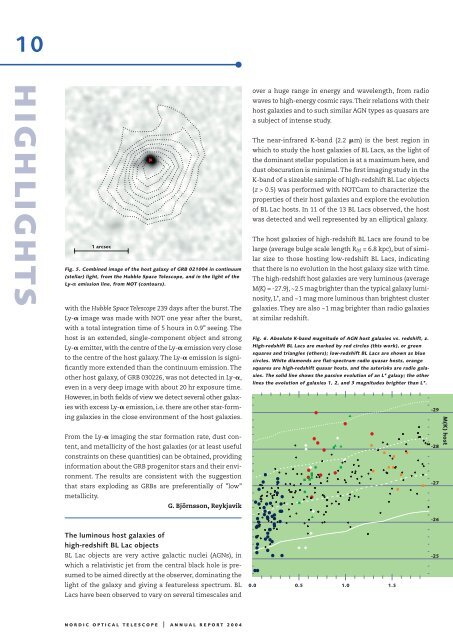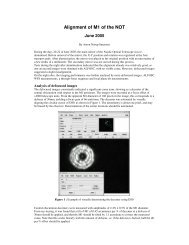NOT Annual Report 2004 (PDF) - Nordic Optical Telescope
NOT Annual Report 2004 (PDF) - Nordic Optical Telescope
NOT Annual Report 2004 (PDF) - Nordic Optical Telescope
You also want an ePaper? Increase the reach of your titles
YUMPU automatically turns print PDFs into web optimized ePapers that Google loves.
10<br />
HIGHLIGHTS<br />
<br />
Fig. 5. Combined image of the host galaxy of GRB 021004 in continuum<br />
(stellar) light, from the Hubble Space <strong>Telescope</strong>, and in the light of the<br />
Ly- emission line, from <strong>NOT</strong> (contours).<br />
with the Hubble Space <strong>Telescope</strong> 239 days after the burst. The<br />
Ly- image was made with <strong>NOT</strong> one year after the burst,<br />
with a total integration time of 5 hours in 0.9” seeing. The<br />
host is an extended, single-component object and strong<br />
Ly- emitter, with the centre of the Ly- emission very close<br />
to the centre of the host galaxy. The Ly- emission is signifi<br />
cantly more extended than the continuum emission. The<br />
other host galaxy, of GRB 030226, was not detected in Ly-,<br />
even in a very deep image with about 20 hr exposure time.<br />
How ever, in both fi elds of view we detect several other galaxies<br />
with excess Ly- emission, i.e. there are other star-forming<br />
galaxies in the close environment of the host galaxies.<br />
From the Ly- imaging the star formation rate, dust content,<br />
and metallicity of the host galaxies (or at least useful<br />
constraints on these quantities) can be obtained, providing<br />
information about the GRB progenitor stars and their environment.<br />
The results are consistent with the suggestion<br />
that stars exploding as GRBs are preferentially of ”low”<br />
metallicity.<br />
G. Björnsson, Reykjavik<br />
The luminous host galaxies of<br />
high-redshift BL Lac objects<br />
BL Lac objects are very active galactic nuclei (AGNs), in<br />
which a relativistic jet from the central black hole is presumed<br />
to be aimed directly at the observer, dominating the<br />
light of the galaxy and giving a featureless spectrum. BL<br />
Lacs have been observed to vary on several timescales and<br />
NORDIC OPTICAL TELESCOPE | ANNUAL REPORT <strong>2004</strong><br />
over a huge range in energy and wavelength, from radio<br />
waves to high-energy cosmic rays. Their relations with their<br />
host galaxies and to such similar AGN types as quasars are<br />
a subject of intense study.<br />
The near-infrared K-band (2.2 m) is the best region in<br />
which to study the host galaxies of BL Lacs, as the light of<br />
the dominant stellar population is at a maximum here, and<br />
dust obscuration is minimal. The fi rst imaging study in the<br />
K-band of a sizeable sample of high-redshift BL Lac objects<br />
(z > 0.5) was performed with <strong>NOT</strong>Cam to characterize the<br />
properties of their host galaxies and explore the evolution<br />
of BL Lac hosts. In 11 of the 13 BL Lacs observed, the host<br />
was detected and well represented by an elliptical galaxy.<br />
The host galaxies of high-redshift BL Lacs are found to be<br />
large (average bulge scale length R(e) = 6.8 kpc), but of similar<br />
size to those hosting low-redshift BL Lacs, indicating<br />
that there is no evolution in the host galaxy size with time.<br />
The high-redshift host galaxies are very luminous (average<br />
M(K) = -27.9), ~2.5 mag brighter than the typical galaxy luminosity,<br />
L*, and ~1 mag more luminous than brightest cluster<br />
galaxies. They are also ~1 mag brighter than radio galaxies<br />
at similar redshift.<br />
Fig. 6. Absolute K-band magnitude of AGN host galaxies vs. redshift, z.<br />
High-redshift BL Lacs are marked by red circles (this work), or green<br />
squares and triangles (others); low-redshift BL Lacs are shown as blue<br />
circles. White diamonds are flat-spectrum radio quasar hosts, orange<br />
squares are high-redshift quasar hosts, and the asterisks are radio galaxies.<br />
The solid line shows the passive evolution of an L* galaxy; the other<br />
lines the evolution of galaxies 1, 2, and 3 magnitudes brighter than L*.



